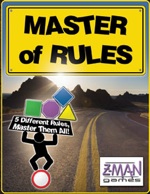
|
About OgreCave and its staff
|

|
by Andy Vetromile
Most games ask you to command a set of rules that bring you a win. In Master of Rules from Z-Man Games, you have to become accomplished at five of them. Making the rules work for you isn't just a means to an end, it's the whole point. The object of the game is to score the most Victory Points through completed rules.
Mastering the game On the first trick, the starting player lays one card of either type face up in front of him. The person to his left then chooses something to put down, and so on. Once play gets back around, the first player plays the other kind of card - that is, if he placed a Rule Card on the table the first go-round, he must put a Number Card down this time. Everyone else follows so each player has two cards before them, and the rules are judged. Depending on the card, a rule may require certain numbers, colors, or combinations be played. Anyone who achieved their rule gets to keep that card for points at game's end. Then a new round begins and the player to the left becomes the new starting player. Once everyone has been first player twice, the game is over and points are scored. You're awarded one point for every Rule Card in front of you. If someone manages to make any sets - one of each of the five types of rule, or three of the same rule - they get bonus points. The player with the highest total wins. The game satisfies graphically and is just about passable in quality. The design on the card selection is bright and easy to read. If there's a quibble, it's with the choices for color and shape matches. There's a chance colorblind players might mistake one color for another, but little probability they'd confuse the accompanying shape that characterizes each suit (unless they mistake the square for the diamond when one card is tilted next to the other). But why isn't the octagon-shaped suit matched with the color red? The game makes obvious use of a highway-signs metaphor, so with green squares and yellow triangles you'd think a red stop-sign motif would make sense for an American audience. Perhaps it's a throwback to the Japanese version (whence the game hails) and such traffic symbols differ? The cardstock feels thin, but the cards seem to hold up okay... for now. The Rule Cards are Limit 23 (the cards for this deal must add up to 23 or less); Trio (three cards are played with the same number or color); Only One (your card is the only one with that number and color this turn); Best of the Best (yours is the highest Number Card from the dominant color suit); and Support Right (if the person to your right achieved their rule, you succeed as well). This may sound like a dizzying array, but it's pretty simple, and fewer options would make one's choices too obvious. While the game works best with the full five, it can also field three or four people; in these cases, a dummy player is used and random cards are played on his behalf. The deck comes with a couple of cards to represent these stand-ins, with the necessary rules printed on them.
Conclusions
|
||
 Master of Rules
Master of Rules